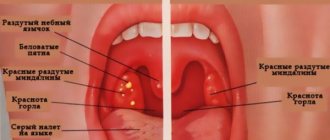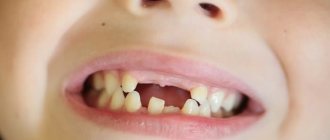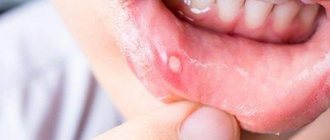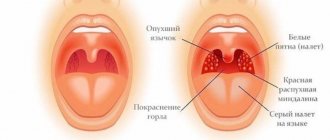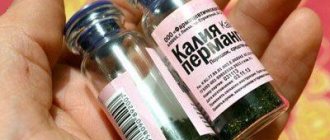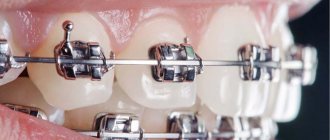Can children use Lugol to treat their throat - composition
The active substances of the drug, which have a detrimental effect on pathogenic flora, are iodine and potassium iodide. And glycerol, present in the composition as an additional substance, softens the effect of the drug on the mucous membranes and skin.
The drug is used in pediatrics.
Indications
The solution is used to combat infectious and inflammatory processes of the mucous membranes of the pharynx and larynx caused by pathogenic bacteria:
- angina;
- laryngitis;
- pharyngitis;
- atrophic rhinitis;
- angular stomatitis.
Staphylococcus aureus and Pseudomonas aeruginosa exhibit resistance to active components. Therefore, it is not advisable to use the drug for diseases caused by these pathogens.
For sore throat
Applying the drug to inflamed tonsils destroys pathogenic microbes that lead to the onset and progression of the disease.
Contraindications
Systematic use of the solution promotes the accumulation of iodine. For people with problems with the thyroid gland, this is not acceptable. It is very important to tell your doctor if your child has these types of problems. Has contraindications:
- allergy to iodine;
- decompensation of heart function;
- hyperthyroidism of the thyroid gland;
- liver and kidney diseases in the stage of decompensation;
- recent medical use of radioactive iodine.
You need to be careful with the dosage of the drug, since frequent and abundant application can lead to excessive irritation of the mucous membrane.
At what age is it prescribed?
The solution can be used with caution from 1 year.
Sprays are suitable for older children who are able to hold their breath while irrigating their throat.
Lugol
Lugol (iodine) is a local antiseptic, available in the form of a spray and solution. Elemental (molecular or pure) iodine exhibits a pronounced antibacterial effect. When applied topically to the skin and mucous membranes, it has an irritating effect, and in high doses it has a cauterizing effect. High activity when used externally is associated with the ability of iodine to precipitate tissue proteins. It should be noted that iodine salts have a significantly less local irritating effect, which manifests itself only against the background of high concentrations of iodides. Lugol has a wide therapeutic range and extends its effect to representatives of both gram-positive and gram-negative pathogenic microflora, as well as fungi, incl. to yeast. The drug is less active against staphylococci, however, with prolonged use, the growth and development of staphylococcal microflora is suppressed. The drug has no effect on pseudomonas. When applied to a large area of the skin and mucous membranes, iodine can be absorbed into the systemic bloodstream and participate in the formation of thyroid hormones - triiodothyronine and thyroxine. Potassium iodide, which is part of the drug as an excipient, increases the solubility of iodine in water, and glycerin somewhat softens the irritating effect. If Lugol is used in the doses indicated in the package insert, the degree of absorption of the active substance into the systemic circulation is insignificant. When applied to mucous membranes, slightly less than half of elemental iodine is transformed into iodides.
When used orally, iodine is very quickly absorbed in the digestive tract, enters the systemic circulation and accumulates in the thyroid gland. Elimination of iodine and its metabolites from the body occurs with urine, and to a lesser extent with feces and sweat. Has the ability to pass into breast milk. Contraindications to taking Lugol are individual intolerance of the body to iodine or excipients included in the drug, kidney disease in the stage of decompensation, pregnancy. During lactation, the question of taking the drug is decided by the doctor, depending on the assessment of the benefit/risk ratio. The method of application of Lugol is external. Frequency of application – 4-6 times a day. A single dose of spray is one press of the spray head. It is recommended not to breathe at the time of injection. Precautions must be taken to prevent spray from getting into the eyes. Long-term (more than two weeks) use of Lugol is contraindicated. The drug has a favorable safety profile. Among the side effects, allergic reactions should be noted, and with prolonged use - rhinitis, urticaria, hypersalivation, acne. When conducting tests for thyroid hormones, it is necessary to keep in mind that taking iodine supplements can affect their results. Iodine potentiates the irritating effect of acetylsalicylic acid on the gastrointestinal mucosa.
Instructions for use and dosage
The solution has specifics of use and precautions that should not be neglected.
How to properly treat a child's throat
In order to smear the throat well, you need to prepare a thin stick (a pen or a regular pencil will do) and cotton wool (bandage).
Execution order:
- We wash and disinfect our hands.
- We securely wrap a cotton swab around the stick.
- Dip the cotton wool into the iodine solution and lightly squeeze the bottom part.
- After the child has opened his mouth wide, carefully lubricate the lacunae of the palatine tonsils. You can learn about herpes sore throat in this article.
At first, the child may complain of a burning sensation, which goes away after some time. You need to smear carefully, bypassing the back wall. Touching it may cause vomiting. The longer the product is on the mucous membrane, the more iodine penetrates into the blood. For this reason, it is advisable to drink water and eat food only after 40 minutes.
It is necessary to prepare the child for the procedure - treatment of the throat should not come as a surprise. It is necessary to explain to him the essence of the procedure and possible sensations during it. It is also important to tell why this is done and what benefits it can bring. The baby should not move, be calm, and not make unnecessary movements.
We will separately highlight the process of use for children 1 year old. The solution must be diluted with clean water in equal proportions. You can find out how to gargle for laryngitis by following the link.
The throat treatment goes like this:
- Thoroughly wash and disinfect the adult’s hands.
- Wrap your finger in a sterile bandage and then dip it in a pre-prepared solution.
- Using a rotating motion of your finger, lubricate the inflamed areas in the child's throat.
From the age of 2 years you can use a spray with a dispenser. It is important to ensure that the child holds, or at least minimizes, his breathing during irrigation - this will prevent swallowing the drug. Algorithm for irrigating the throat with a spray:
- The child opens his mouth wide.
- Closes eyes to prevent aerosol from entering them.
- An adult sprays the drug by pressing the tip once. Find out whether you can wash yourself if you have a sore throat.
Despite the ease of use, there is a serious drawback - when irrigating the throat, the medicine does not reach the entire inflamed surface, and this reduces the effectiveness of the drug.
How to dilute for rinsing
For inflamed areas that cannot be anointed manually, it is better to rinse. To do this, add a few drops of the solution to 1 glass of water. Control the water temperature - it should not be hot, nor too cold. It is recommended to gargle from the age of 6 years.
It is possible at a younger age, the main thing is that the child knows how to do it correctly. There are also ready-made rinsing solutions available for sale. You can find out how to get rid of snot in an adult’s throat here.
Treatment regimen: duration of therapy
The treatment regimen is selected by the attending physician based on the collected medical history. The effectiveness of treatment and the speed of recovery depend on the dose and frequency of use of the drug. You need to treat your throat with a solution and spray 3-6 times a day, gargle 4-5 times.
Precautions and possible side effects
Excessive use may lead to adverse reactions:
- allergic rashes, including urticaria;
- feeling of irritation, soreness and dryness in the throat;
- cough;
- increased salivation;
- sleep problems;
- tachycardia;
- inhibited reactions;
- weakness in the muscles of the body;
- swelling of the larynx;
- burn of treated areas;
- nasal congestion;
- iodism.
The drug, used according to the regimen specified by the doctor, does not affect the child’s activity. With prolonged and systematic use of the drug, iodine is absorbed and accumulated, resulting in suppression of the thyroid gland.
Up to 2 years, when spraying the spray, spasm of the muscles of the larynx and bronchi (laryngospasm and bronchospasm) may occur. This is not a feature of Lugol; this applies to all sprays with any active ingredients.
Lugol's is not intended for internal use; it is only allowed to be used externally.
If a drug with iodine is used for the first time, then before starting treatment it is necessary to conduct a skin test. To do this, apply a small amount of the substance to the elbow or wrist. After a few hours, ideally a day, examine the treated area of skin. If a rash appears, redness, itching, or pain occurs, stop use immediately.
The drug disintegrates in the presence of thiosulfate, so if the solution gets inside, the stomach is washed with this substance.
Lugol's solution with glycerin 50ml with spray
A country
Russia
The country of production may vary depending on the batch of goods. Please check with the operator for detailed information when confirming your order.
Active substance
Iodine + Potassium iodide + Glycerol
Compound
potassium iodide, glycerol.
pharmachologic effect
Elemental iodine has pronounced antimicrobial properties. Elemental iodine preparations are characterized by a pronounced local irritating effect on tissue, and in high concentrations, a cauterizing effect. The local effect is due to the ability of elemental iodine to precipitate tissue proteins. Preparations that eliminate elemental iodine have a much less pronounced irritating effect, and iodides have local irritating properties only in very high concentrations. The nature of the resorptive effect of elemental iodine preparations and iodides is the same. During the resorptive effect, iodine preparations have the most pronounced effect on the functions of the thyroid gland. In case of iodine deficiency, iodides help restore impaired synthesis of thyroid hormones. With normal iodine content in the environment, iodides inhibit the synthesis of thyroid hormones, the sensitivity of the thyroid gland to pituitary TSH decreases and its secretion by the pituitary gland is blocked. The effect of iodine preparations on metabolism is manifested by increased dissimilation processes. In atherosclerosis, they cause a slight decrease in the concentration of cholesterol and beta-lipoproteins in the blood; in addition, they increase the fibrinolytic and lipoproteinase activity of blood serum and slow down the rate of blood clotting. Accumulating in syphilitic gums, iodine promotes their softening and resorption. However, the accumulation of iodine in tuberculosis lesions leads to an increase in the inflammatory process in them. The release of iodine by the excretory glands is accompanied by irritation of the glandular tissue and increased secretion. This is due to the expectorant effect and stimulation of lactation (in small doses). However, in large doses, iodine preparations can cause suppression of lactation.
Indications for use
For external use: infectious and inflammatory skin lesions, trauma, wounds, myalgia. For topical use: chronic tonsillitis, atrophic rhinitis, purulent otitis media, trophic and varicose ulcers, wounds, infected burns, fresh thermal and chemical burns of I-II degree. For oral administration: prevention and treatment of atherosclerosis, tertiary syphilis.
Mode of application
When used externally, damaged areas of the skin are treated with iodine. For oral administration, the dose is set individually, depending on the indications and age of the patient. Topically used for washing lacunae and supratonsillar spaces - 4-5 procedures at intervals of 2-3 days, for irrigation of the nasopharynx - 2 -3 times a week for 2-3 months, for instillation into the ear and rinsing - for 2-4 weeks; in surgical practice and for burns, gauze napkins applied to the affected surface are moistened as needed. Contraindicated for oral administration during pregnancy. Contraindicated for oral administration in children under 5 years of age.
Interaction
Pharmaceutically incompatible with essential oils, ammonia solutions, white sedimentary mercury (an explosive mixture is formed). An alkaline or acidic environment, the presence of fat, pus, and blood weaken the antiseptic activity. Reduces the hypothyroid and goitrogenic effects of lithium preparations.
Side effect
For external use: rarely - skin irritation; with prolonged use on large wound surfaces - iodism (rhinitis, urticaria, Quincke's edema, salivation, lacrimation, acne). When taken orally: allergic skin reactions, tachycardia, nervousness, sleep disturbances, increased sweating, diarrhea (in patients over 40 years of age) ).
Contraindications
Hypersensitivity to iodine. For oral administration - pulmonary tuberculosis, nephritis, nephrosis, adenomas (including the thyroid gland), furunculosis, acne, chronic pyoderma, hemorrhagic diathesis, urticaria, pregnancy, children under 5 years of age.
special instructions
With prolonged use, phenomena of iodism are possible.
